
Guyton Guitars Red Special Limited Edition
The Guyton Guitars Red Special
![]()
world-exclusive to brianmayworld.com - the first
review ever!
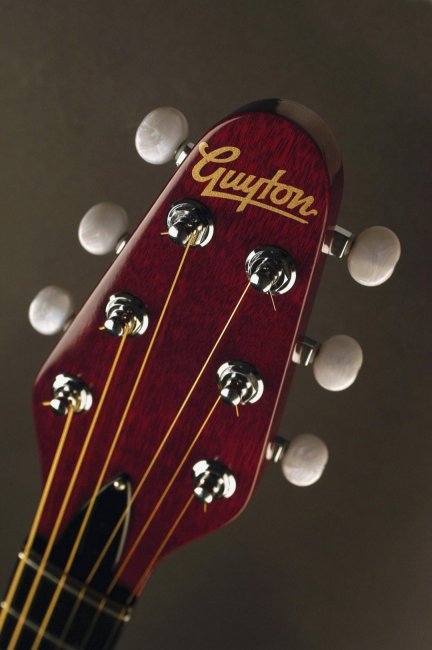
We all know the history behind one of the most incredible guitar creations.
The Red Special was a combination of a father and son project, and
their respective intelligence, to create a unique guitar with some very
different but important features through many ideas and experiments. Their
designs produced what is possibly the forerunner to the modern day rock
guitar.
The Red Special is still functioning almost 40 years on. Besides the
recent restoration by Greg Fryer (to prevent the guitar from suffering
further severe deterioration) it has stood the test of time.
All the original parts on the guitar are still there and the knife-edge
tremolo system still performs perfectly without showing any signs of wear.
This all goes to show that the whole guitar was originally designed to
last.
Andrew Guyton has taken on a very difficult project. He admits that
the guitar was a lot different to how he imagined.
Recent X-rays that were taken of the Red Special at a London hospital
revealed the details of the hidden cavities. It also gave him a clearer
idea of the construction.
Viewing the original plans (drawn up by Brian and his father) and stripping
the original guitar down to take measurements, Andrew came up with detailed
plans which were transferred to CAD for extremely accurate plans to work
from.
Two prototype replicas were constructed using the same woods, glues
and metals as used on the original.
The neck
The neck was carved out of one-piece mahogany and has an oak fingerboard.
It bears the fixing bolt and the exact same truss rod design that is wrapped
around the fixing bolt and runs through the neck at an angle to the fingerboard.
The adjustment is made at the headstock end with an adjustment nut.
The fingerboard has the same 7 ¼ inch radius and, zero fret
and brown Bakelite nut. The oak has been blacked and lacquered.
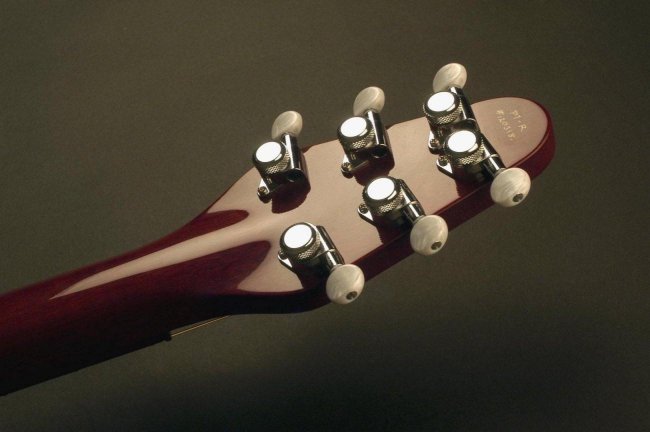
The neck profile is replicated with the same width and depth. It has
a deep but gentle “C” shape from the body end to about the 7th fret where
the profile begins to change to a gentle “V” shape. The back of the neck
is blended into the back of the headstock as the original.
Body
The body construction is very complex. The general shape of the guitar is constructed out of two halves of Blockboard. There are oak inserts in the two halves, which make up the central core of the guitar. The cavities are created by the removal of most of the inside faces of the blockboard creating sound chambers. The control cavity has different levels of cavities creating an unusual design. All the internal cavities have been replicated using the information that Andrew has obtained.
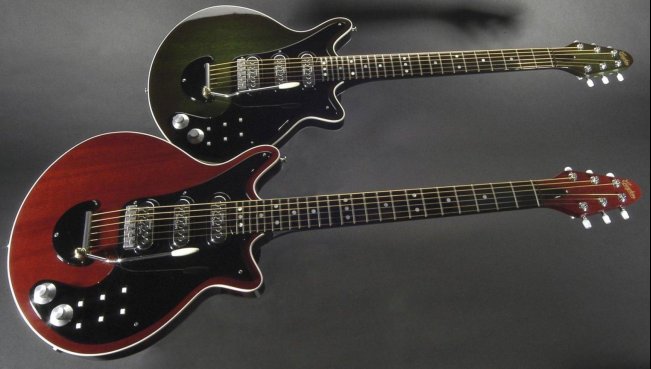
The body is screwed and glued together with the screw positions the
same as the original.
This creates a very solid structure.
The binding is of the same size and is joined at the neck heel with
a larger piece of white plastic that is blended into the neck as it joins
the body.
The front, back and sides of the body are then veneered with mahogany.
Hardware
The tremolo system has been faithfully replicated and is made to a high
standard of quality. The springs have recently been upgraded (on Brian’s
request) to give the tremolo the same feel as his own.
The tremolo is adjustable via two holes either side of the rear strap
button. A screwdriver is inserted into the hole and locates in a slot in
each adjusting bolt. This eliminates the need to keep removing the tremolo
cover plate to make adjustments. Again, this is a feature on the
original guitar.
Andrew has carefully shaped the plastic tip on the end of the tremolo
arm exactly like the original one that was made from a fat knitting needle.
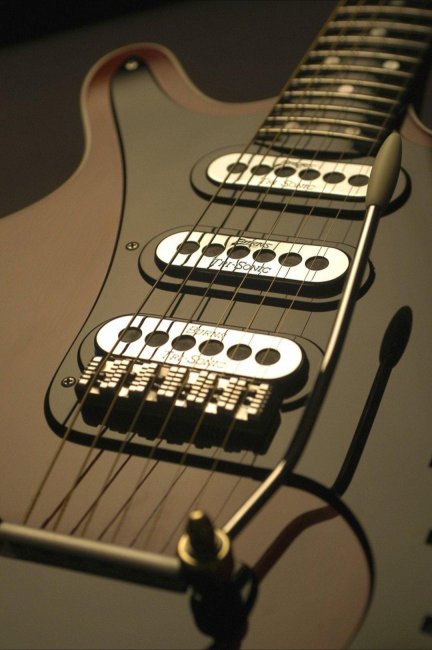
The roller-bridge has been replicated exactly. The rollers are one-piece
stainless steel and rest on the top of the individual aluminium bridge
pieces. The string holds the roller in position. Snapping a string will
cause the roller to drop out of its intonation slot. This is the original
design and has been faithfully replicated.
The bridge pieces have been nicely rounded and smoothed to a mirror
like finish.
The same locking tuners are fitted with pearloid tips.
The volume and tone knobs have been made with the same straight knurling
and red dot on the lower skirt.
One thing I found very interesting is that Andrew went to a lot of
trouble to modify the white slide switches. On the original guitar the
switches have smaller actuators. They are also long obsolete. Andrew has
stripped down each switch and had each actuator reduced in size to give
the same appearance on the scratchplate. He has also removed the “click”
from each switch as the originals move freely without a positive on/off
movement that new switches have.
The original jack socket is also an obsolete item. Rather than use
a barrel jack he has chosen to use an open jack socket which gives the
same appearance on the edge of the guitar.
All the original electric’s are mounted on two aluminium plates. One
plate contains the switches and another holds the volume and tone pots.
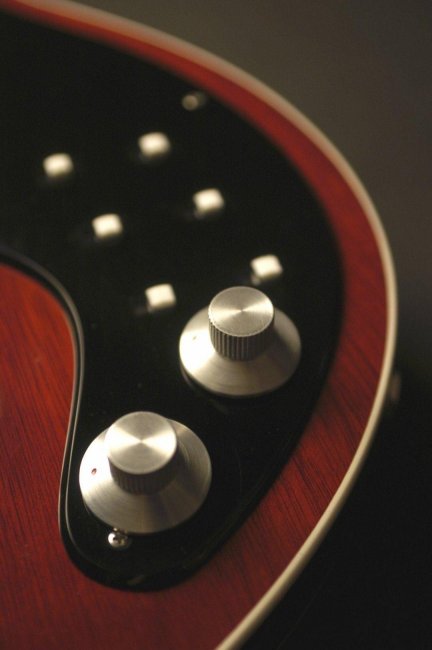
Andrew has hand-made both plates. The plate containing the switches
is mounted just beneath the scratchplate and held into place with two screws
on wooden supports and a “leg” at the back of the plate screwed to a lower
level in the control cavity. The volume and tone pots sit on a “kidney”
shaped plate that is set into the body lower down on a square wooden mounting
block with a screw. Certainly an unusual idea in its day but these are
well fitted and accurately placed.
Pick-ups
The Tri-Sonics pick-ups have been specially wound to the same specs as
Brian’s. Visually they are the same as regular Tri-Sonics but have the
advantage of specific winding values to re-create the originals on Brian’s
guitar. These have been specially made for this run of guitars only. They
are not available otherwise.
Scratchplate
The scratchplate, tremolo cover and truss rod cover are made from black
Perspex. The shape has been taken from the original. It has the same cut
out near the bridge so that the scratchplate can easily be removed without
removing the strings or the bridge. The edges are nicely bevelled. The
screws are positioned in the exact same positions and the same types of
screws will be used.
Finish
Both
prototypes were constructed exactly the same. Andrew will be making 40
in the original Red colour and 10 in the Green colour.
The one thing I liked about the finish on these guitars is that the
grain was completely visible through the stain and lacquer. I thought the
grain detail was stunning and certainly not unlike the original.
The neck and fingerboard were very slippery and very nice to handle.
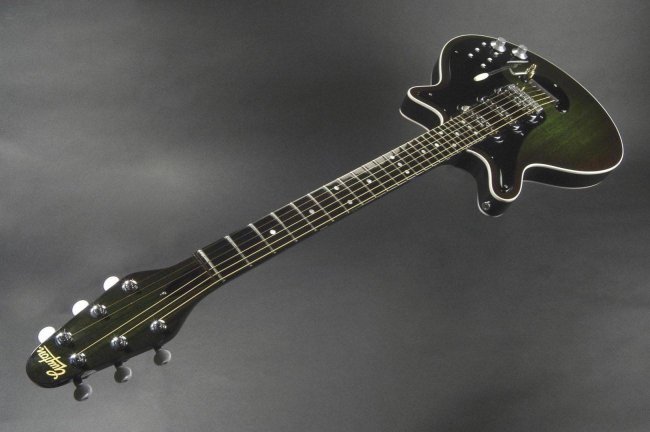
Although the Green finish was stunning, I personally preferred the Red
one. The colour was so close to how I remember the colour of the original
Red Special when I saw it in the flesh back in 1998.
It would seem that Andrew had carefully chosen the veneer for the front
of the guitars to have the dark mahogany stripes like the original.
Performance
I played the prototypes through a Vox AC30, treble booster and played with
a Sixpence. There was very little difference between them. I did
find that the Green model was a little warmer in tone and the Red model
was a little brighter.
Considering both guitars were made with exactly the same construction
and materials I guess the slight variations in the wood and pick-ups can
only be the reason for the slight differences.
Immediately obvious was the ringing sustain. The fingerboard was so
well fretted and smooth that each note sustained wonderfully. String bending
provided no choking, as the strings were set quite low. A 7 ¼ inch
radius is certainly not that bend friendly but was not a problem on these
guitars.
You needed no effort to play chords. A light touch is all that is needed
for these guitars to perform.
I could find no problems playing anywhere on the fretboard.
The pick-ups had been nicely balanced. I was fortunate to have played
these guitars after Brian had put them through their paces. He had asked
Andrew to tweak the pick-up heights to his taste while A/Bing them with
his own.
There is a lot of warmth to the tone of these guitars. I think I would
have expected that, as Brian’s tone is very warm to my ears. It was a rich
tone but there was also clarity. I think the combination of the cavities
gives it a rich sound and the hardness of the oak gives it springiness.
There is always a gentle twang to it.
The combination of the pick-ups in and out of phase made no real change
to the volume level. There was no sudden drop in volume from an in phase
sound to an out of phase sound. This could well be that the pick-ups were
so well balanced that they complimented each other in any setting.
At low volume the gain disappears and gives a sweet clean sound.
A gradual build up on the volume control slowly brings in the gain to a
real powerful sound with the bridge and middle in phase. I tried all pick-up
settings and I could hear them all, as I would expect to hear them. The
neck and middle out of phase really did screech. Almost ear piercingly
bright.
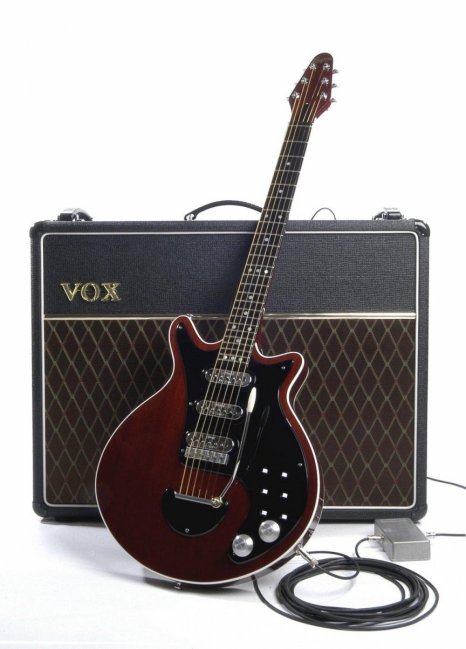
The feedback sound was very wholesome and controllable. The pick-ups
did not go microphonic. There was a climbing effect on the feedback. Moving
up an octave after a short time. That was good to hear. It also did not
die off.
Overall I felt that these special pick-ups really were something special.
Replicas of a tried and tested set of Tri-Sonics have to be good!
The tremolo system was fantastic. You can drop the bottom E to nothing
and there were no tuning problems. In fact I checked the tuning three or
four times while playing and I never needed to tweak it once. The tremolo
was very positive and there was no play in the tremolo arm. The arm was
not too loose or too tight. This is quite important if you want a delicate
ripple to the notes.
Verdict
Having spoken to Andrew Guyton (on various occasions) about his guitar
construction and his own personal thoughts on the Red Special, I genuinely
believe he is as much a fan of the guitar as many others and I are. He
has a genuine respect for Brian and Harold May’s creation.
He explained that he wanted to replicate the entire guitar from scratch
and that he wanted every part of the guitar to be as close as is possible.
Some parts of the original guitar are now long obsolete but Andrew has
found ways around this (as I have explained in parts of this review).
These guitars will be a very important part of the history of the Red
Special. The construction has been relived by Brian 40 years on and must
have brought back many memories for him. From this, some very special replicas
have been born.
Brian May, Pete Malandrone, and Greg Fryer have worked closely together
with Andrew Guyton to help produce these prototypes. The production run
will be no different to the prototypes.
To any real fan of the Red Special these have to be the ultimate replica.
They are expensive but they are the products of many months of research
and construction. They are a limited run and will all be instant collector’s
pieces.
But I have to believe that they have been made with as much care and
enthusiasm as the original creators.
Guyton Guitars website:
http://www.guytonguitars.co.uk/
Special thanks to Andrew Guyton for his time and kindness.
Pictures are copyright of Andrew Guyton.
the report is (c) by brianmayworld.com
Mark Reynolds
March 2004